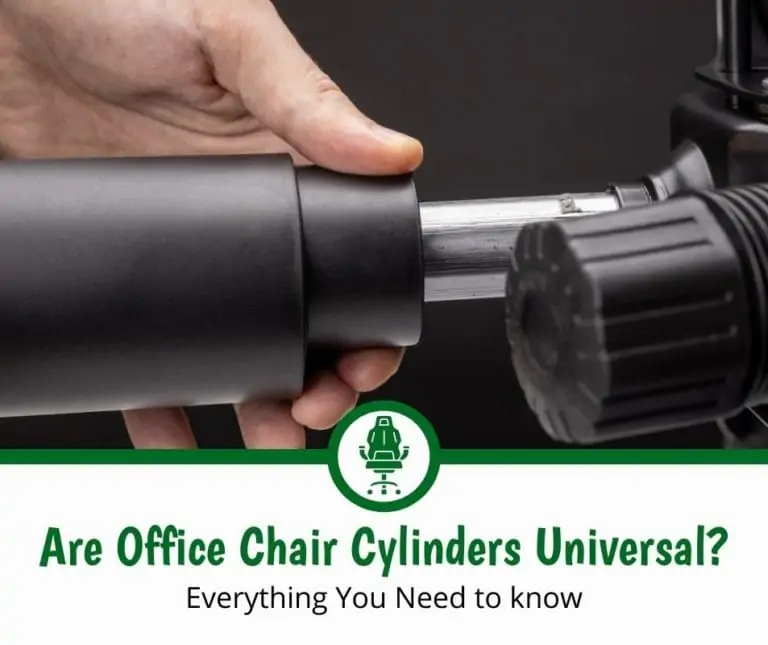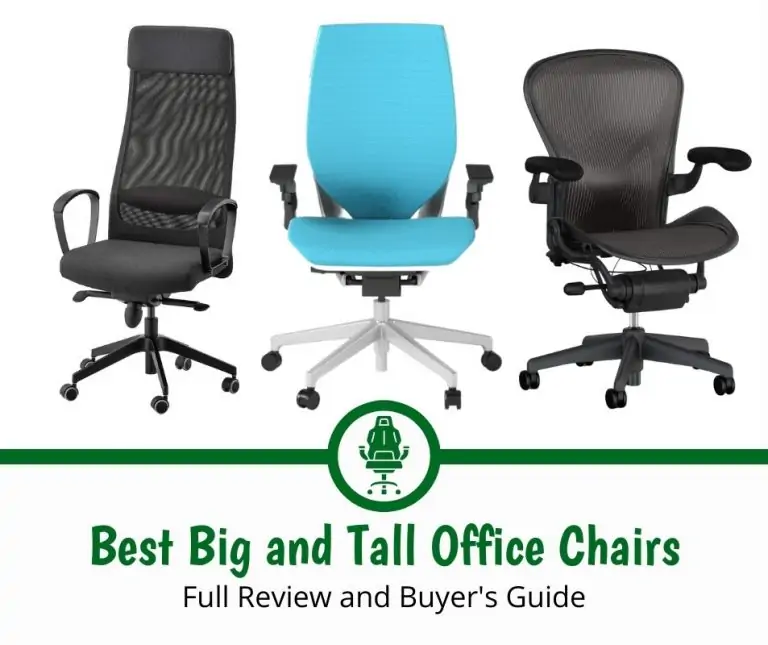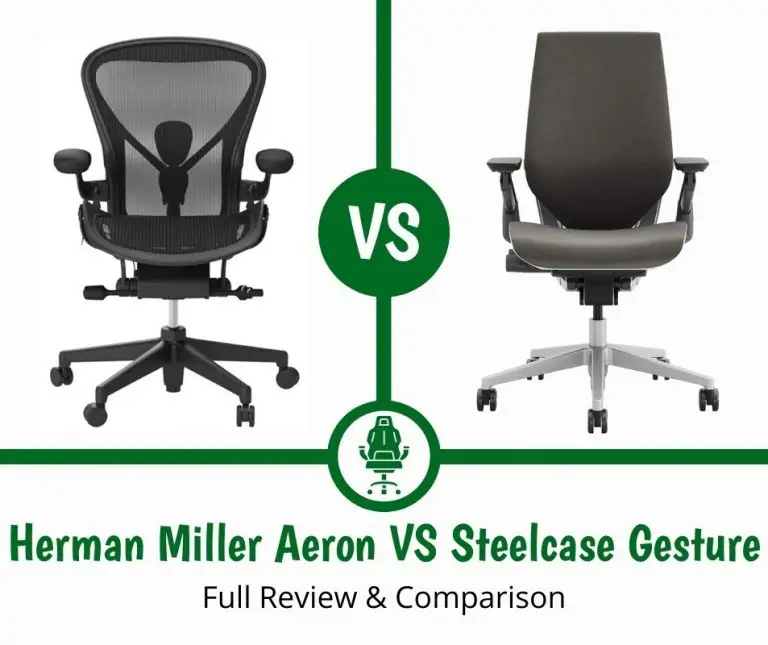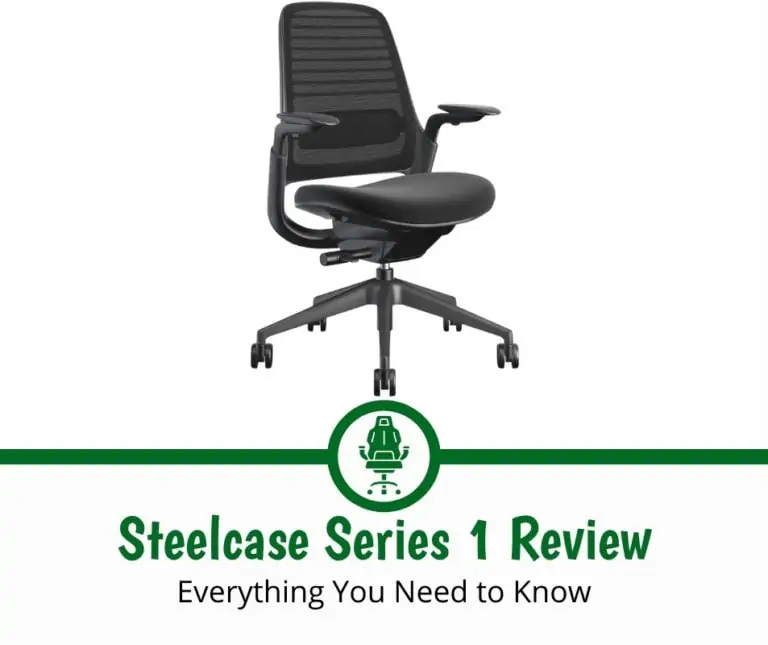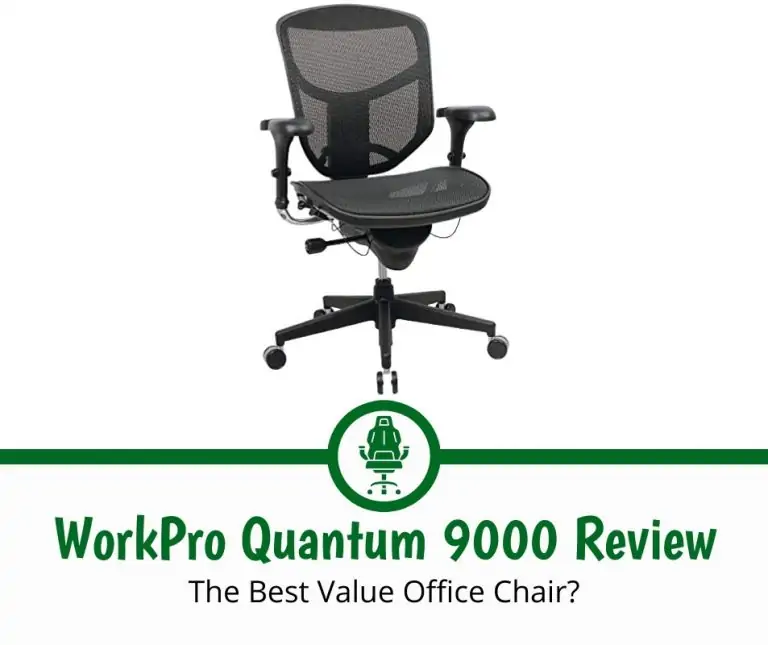Fabric vs Leather Chair: Which Is Best for You?

You’ve decided that you want an upholstered office chair. Fabric is a common upholstery material, so that might be one you’re strongly considering. Then again, there’s also leather, which just looks so good. Which is the better office chair material?
Leather office chairs win in the looks department, and their breathability and longevity outpace a fabric chair. Fabric office chairs cost less money, and you usually have more color options. Plus, fabric is easier to clean and maintain than leather.
If you’re still feeling stuck between a fabric or leather office chair, you certainly shouldn’t by the time you’re done reading. This article will review both types of chairs in detail, then compare them on the aspects you care the most about such as aesthetics and price.
Let’s dive right in!
Fabric Chairs Overview
Fabric is kind of a catch-all term for office chairs that aren’t mesh but aren’t upholstered in leather either.
In many cases, when referring to fabric, an office chair manufacturer really means polyester. Made from polyester fibers or yarn, polyester is an appealing option to office chair manufacturers since it’s low-cost but looks good enough.
Polyester resists stains well so it holds up longer. The fabric is also flexible where you need it so it won’t rip or tear if you sit in a polyester office chair for long enough.
Although it has the reputation of being cheap, not all polyester is created equally. For example, take a look at Herman Miller’s materials overview on their website.
The brand’s polyester is called Terra. It’s post-consumer recycled polyester, and the fabric is completely biodegradable. It’s also quite high-quality stuff.
That’s not the only brand of polyester fabric that Herman Miller offers. Sync and Medley are two additional polyester upholstery options you can select from for some of their office chairs, one of those being the Embody.
The polyester that’s used to make these upholstery collections undergoes the Wyzenbeek test. In other words, the polyester enters a machine with an abrasive cotton duck material. The duck material rubs on the polyester using double rubs to determine when wear occurs.
For both the Sync and Medley fabrics, Herman Miller promises 100,000 double rubs.
Herman Miller isn’t the only brand that has gotten onboard with polyester. The Steelcase Gesture is one of the most beloved office chairs outside of Herman Miller. This chair is anything but cheap, costing $1,300.
The Gesture uses Cogent fabric, which is pure polyester. You would never guess it though considering the exceptional quality of the polyester.
The Steelcase Leap, another beloved office chair, also features polyester upholstery. Rather than come equipped with Cogent fabric though, the Leap includes Steelcase’s Buzz2 fabric. This too is pure polyester.
I do want to be clear on something. The term fabric is not always synonymous with polyester, just most of the time. In some cases, fabric could refer to microfiber, as is the case with the OFM ESS Collection high-back office chair.
This chair proves that you can have a stately-looking, high-quality, and comfortable office chair on a budget, as the OFM office chair retails for under $250 before you add in assembly charges (provided you want professional assembly).
The Secretlab Titan XL 2020, a gaming chair that makes an exceptional office chair, uses another type of fabric altogether. This is the brand’s own SoftWeave fabric.
According to Secretlab, SoftWeave is “a technical fabric inspired by performance footwear” that features durable yarn fibers interwoven into loops using a 3D gradient knitting technique.
Breathable, soft, and strong, SoftWeave is one of the best examples of non-polyester office chair fabric.
Leather Chairs Overview
Okay, so that was fabric. Now it’s time to talk about the other office chair material you’ve been strongly considering, and that’s leather.
Leather is an upholstery material that’s sourced from animal skins. The skins are tanned or otherwise chemically treated.
Like fabric, not all leather is created equally. Leather can be artificial or the real deal. If you want only real leather for your office chair, then you have to get good at sniffing out the differences.
Let’s start by talking first about real leather. Even among real leather, some of it is realer than others.
For example, look at bonded leather. Bonded leather will include a series of leather scraps glued or otherwise attached together. The amount of real leather in bonded leather can be as high as 90 percent and as low as 10 percent. That’s a huge difference.
Although bonded leather is mostly filler material and thus not the upholstery that’d be used for an office chair, you never know. If bonded leather contains only 10 percent real leather, then the other 90 percent is an amalgamation of latex and polyurethane.
Real leather is graded or categorized by its grain. Grain in leather refers to how the hide looks due to its composition. Here’s an overview.
- Enhanced-grain leather: If the leather that comprises your office chair is enhanced grain, it’s top-grain leather that undergoes a treatment. The manufacturer buffs the leather to treat hide imperfections and often adds grain paint as well. The treatments tighten up the fiber structure of the leather, increasing its durability even though it costs less.
- Split-grain leather: When manufacturers cut leather from the lower hide, this is split-grain leather. This type of leather allows you to see down to the leather’s bottom material, hence the name split grain. Flexible for embossing and coloring the leather, split-grain leather is also used to make suede. Compared to other leather cuts though, it’s not that great.
- Full-grain leather: Next, there’s full-grain leather, which is top-grain leather (more on this in just a moment) that maintains its natural grain. In other words, it doesn’t have a grain print. Any imperfections are there for anyone to see, which means that only the greatest quality hides are used to make full-grain leather products. That makes them very expensive.
- Top-grain leather: Finally, top-grain leather is sourced from the top of the hide. The fibers here have greater density and thus durability and strength. Top-grain leather includes Nubuck leather, which is among the costliest type.
The Secretlab Titan Evo 2022 is an example of a chair that offers real leather upholstery. The brand’s Napa leather stays cool when you sit on it and is supposed to feel smooth like butter. Known for its resiliency, strength, and breathability, Secretlab’s Napa leather is a premium upholstery option for equally premium prices.
I also have to talk about faux leather aka artificial leather. Faux leather is made of synthetics but not a real animal hide.
As I’m sure you can imagine, since it doesn’t use animal hides, faux leather is a lot more cost-effective than real leather in an office chair.
PU leather is fade-resistant and stain-resistant. If you’re comparing PU leather against bonded leather, then yes, faux leather would come out on top. For any other real type of leather though, you’re much better off with the real deal.
Real leather will breathe better than synthetics, although neither breathes that great. Plus, faux leather is a lot likelier to develop that ugly cracking problem that then reveals the foam underneath. If you puncture a faux leather chair, the damage will be far more noticeable than if you punctured real leather (but please don’t do that).
Not all faux leather is bad though! Secretlab’s NEO hybrid leatherette, a feature in the Titan Evo 2022 chair, promises 12 times better durability than the competitor’s PU leather. It’s designed to feel like Napa leather but without the huge price tag, and it’s breathable like real leather as well.
Fabric vs. Leather Chairs: What’s the Difference?
Now that I’ve introduced you to both fabric and leather office chairs, I want to go through and discuss the differences between the two materials in more depth. This section will be your biggest aid as you select the upholstery material for your chair.
Comfort
Comfort is partially subjective, but not entirely.
The comfort of your office chair upholstery is entirely dependent on how much money you’re willing to spend.
For instance, cheap polyester is going to look fine (mostly), but it will feel cheap. If you’re wearing a skirt and working, the material can be itchy and scratchy against your skin. It’s rough and not something you want to sit on for hours at a time.
Quality fabric like high-end polyester or microfiber feels great on the skin. You won’t have to worry about itchiness or scratchiness. The chair looks and feels great. Using your office chair is a delight day after day.
It’s the same story for leather. PU leather will look good and can even feel nice at first, but time will do its terrible dance. The seat and back of your chair can begin to crack. That won’t feel good to sit on.
Real leather is going to be buttery smooth and soft. It’s unlikely to crack, although that depends on whether you misuse your chair.
Of course, leather–faux or real–has an issue that fabric doesn’t. In the heat, you can stick to the chair. Either that or you’ll slide right off if your legs are sweaty.
That’s not to say you won’t sweat in a fabric chair. Polyester is not as breathable as leather, and remember, leather isn’t all that breathable.
When you sweat in a polyester office chair, you won’t slide in your chair. The sweat will absorb into the fabric and make it stinky.
Durability
According to Weekends Only Furniture & Mattress, leather has four times the durability of fabric.
Could polyester and other fabrics be more durable than leather? Yes, in a select few cases.
For example, if you buy a faux leather chair outside of a high-end brand like Secretlab, then your chair is made of synthetic materials. Those synthetics probably wouldn’t outlast even standard polyester.
When it comes to quality polyester like that from Herman Miller or Steelcase, PU leather would lose in the durability department.
Even bonded leather, which is technically real leather, probably wouldn’t outlast high-quality fabric. That would be true only if the amount of leather in the bonded leather was 10 or 20 percent.
If the chair was more leather than latex or polyurethane, then polyester or other fabrics would probably fare better over the long term.
Maintenance
Which is easier to maintain, fabric or leather? After all, the amount of cleanup your office chair requires could encourage you to buy a certain material or shy away from it.
When polyester gets dirty, you can usually use water and dish soap in a bowl to clean stains when they happen. You don’t want to wait too long, as a stain can set in and then will be much more difficult to remove.
To clean up crumbs, loose dirt, and other such debris, you can use a handheld vacuum cleaner on the seat and back of your office chair. The vacuum will lift the debris without it staining the fabric of your chair.
Cleaning microfiber isn’t all that different. I’d again caution you to remove stains when they happen. Try not to ground in whatever you stained the chair with, as that too makes it hard to get out.
You can use a handheld vacuum cleaner to suck up debris on your leather chair the same way you would a fabric office chair. Unlike fabric, it’s harder for dirt to get ground into the leather. That said, it can happen.
Leather can stain. Since it’s porous, it absorbs your skin oils, so it’s more than just ink spills or coffee spills you have to worry about. Leather stains can be harder to remove, but not impossible.
For ink stains, rubbing alcohol is helpful. If skin oils have left your leather office chair discolored, try a combination of cream of tartar and lemon juice.
For basic cleaning, you can tidy up your leather upholstery with dish soap and water. The dish soap should always be mild as well as uncolored and unscented just to be on the safe side.
When you’re done, it’s not a bad idea to condition your leather office chair like you’d condition your hair. You can use a store-bought leather conditioner for this. Some chair owners use a dollop of olive oil on a soft cloth.
When I say a dollop, I mean it. If you overdo it on the olive oil, your office chair will look greasy rather than smooth, shiny, and conditioned.
It’s easier to clean a fabric chair, as you don’t need as many products. You can also skip the conditioning.
Aesthetics
Whether you find a fabric or leather office chair more aesthetically pleasing will depend on your personal tastes.
Both chairs have their benefits in the looks department. Fabric chairs are timeless. Plus, as I touched on in the intro, they’re often available in a greater range of colors than leather. That will matter more to some chair shoppers than others.
Leather is undeniably appealing. It gives off a posh air that a fabric chair can’t touch. You’ll feel like an office executive in a leather office chair, even if you don’t have as many color options.
Price
The upholstery of an office chair is one of many factors that go into its price. Herman Miller office chairs cost close to $1,500 while a Secretlab chair with Napa leather is around $900 even though polyester is supposed to be cheaper.
As a general rule though, real leather will always cost more than polyester and other fabrics, especially if we’re talking about full-grain and top-grain leather.
Fabric vs. Leather Chair: Pros and Cons
Are you still stuck between fabric and leather upholstery for your next office chair? This pros and cons section will recap everything I’ve discussed to this point and help you in your decision-making.
Fabric Chair Pros
- Fabric office chairs are classic yet modern.
- You can opt for bright, fun colors or neutrals for a more buttoned-up office environment.
- Fabric can include polyester but isn’t exclusively that material.
- Cleaning fabric isn’t difficult and requires nothing more than water and mild dish soap.
- A fabric office chair usually costs less than leather, at least if you’re comparing the cost of upholstery alone.
Fabric Chair Cons
- Polyester can be cheap, so if you see a low-cost fabric office chair, it might not be all that durable.
- It’s easy to grind in stains in a polyester chair, often without meaning to.
- Fabrics such as polyester do not breathe as well as leather. Your chair can become stinky without good airflow.
Leather Chair Pros
- Leather is the embodiment of class, appeal, and luxury.
- Keeping your leather office chair clean is more time-consuming but not necessarily difficult.
- A leather office chair is a statement-maker that will tell everyone you mean business.
- Although leather doesn’t come in a huge range of colors compared to fabric, you usually have a few color options that are work-appropriate.
- Leather is more breathable than polyester fabric, but it’s not very breathable overall.
Leather Chair Cons
- It can be hard to tell real leather and faux leather apart unless you know what you’re looking for.
- Bonded leather can be cheap and less beneficial than PU leather and even cheap polyester.
- Leather costs a lot more than fabric.
Tips for Choosing a Fabric Office Chair
Are you leaning more towards a fabric office chair over a leather one? The following tips will ensure you find an excellent chair that you can use for a long time to come.
Choose High-Quality Fabric
Going back to my point from way earlier in this guide, not all fabric is created equal. If you buy cheap polyester, then your chair is going to breathe horribly and not feel very comfortable when you use it for long periods.
Even if you don’t buy a Herman Miller or a Steelcase office chair, you should still prioritize quality fabric.
Sit in the Chair If You Can
Of course, it’s hard to tell from some online photos and videos what sitting in a fabric chair will feel like. That’s something that you can only experience if you visit a store or a showroom and sample the chairs.
Even if the chair model you’re looking at online isn’t available in stores, the fabric it’s made from is. Find a comparable chair in a store and give it a spin. If the material feels too rough after a few minutes, it won’t feel better after using the chair for eight hours a day.
Ask for a Fabric Sample
It doesn’t hurt to be triply sure that that fabric office chair you want to buy is the perfect chair for you, especially if you’re shelling out for a Herman Miller chair.
I’d recommend contacting the manufacturer and asking them to send you a fabric sample.
The sample might not be free, but at least you can feel what the fabric is like before you spend your hard-earned money on an office chair!
Tips for Choosing a Leather Office Chair
Perhaps you’re gravitating more towards a leather office chair. If so, then these shopping tips will guide your purchasing decision.
Know If Your Chair Is Real Leather
Some people might want a high-quality faux leather chair to save some money. If you’re not in that camp though, then you must be 100 percent clear that your chair is made of real leather.
How can you be sure? Check the chair’s tag or label. If you’re browsing around for leather office chairs online, read the description. The product materials should be included somewhere on the product page.
Choose High-Quality Leather
Even real leather comes in different grades depending on the grain. The higher up on the hide the leather is cut, the stronger and more durable it is thanks to the higher density. When using the lower hide to make a leather chair, it’s less dense and thus won’t last as long.
Make a Sizable Budget
Real leather comes with quite a hefty price tag, so make sure you have the budget for it. You should have your chair for at least five years and maybe twice that if you care for it well.
Fabric vs. Leather Chairs: Which Is the Best for You?
Both fabric and leather office chairs have their advantages, but which is the better pick?
That depends on what’s most important to you when buying an office chair.
If you care about looks, then the choice is yours. Should you want to save some money, then PU leather or low-quality polyester will be cheap but nowhere near as long-lasting as better-quality fabric and real leather.
Both chairs clean up easily enough, although maintaining a leather chair is more effort-intensive. The two upholstery materials can be about equally comfortable too, especially if your office chair has ergonomic features (which many do).
That brings us to longevity and price. Leather office chairs will outlast most fabric chairs, but you end up paying more for them.
Conclusion
Fabric and leather office chairs are two disparate upholstery materials that make for a high-end sitting experience. Both types of upholstery have their pros and cons, most noticeably leather’s very high price tag (for real, quality leather at least) and polyester’s sometimes cheap feel.
I hope this guide helps you choose the right upholstery choice for your office chair!


